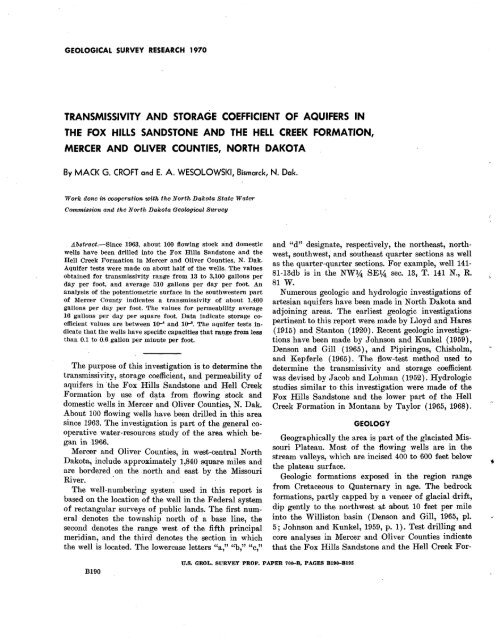RESEARCH· ·1970·
RESEARCH· ·1970·
RESEARCH· ·1970·
You also want an ePaper? Increase the reach of your titles
YUMPU automatically turns print PDFs into web optimized ePapers that Google loves.
GEOLOGICAL SURVEY RESEA~RCH 1970<br />
TRANSMISSIVITY AND STORAGE COEFFICIENT OF AQUIFE:Rs IN<br />
THE FOX HILLS SANDSTONE AND THE HELL CREEK FORMATION,<br />
MERCER AND OLIVE'R COUNTIES, NORTH DAKOTA<br />
By MACK G. CROFT and E. A. WESOLOWSKI, Bismarck, N. Oak.<br />
Work done in 0001Jeration with the North Dakota State Water<br />
Commission and the Nwth Dakota Geological Survey<br />
Abstract.-Since 1963, about 100 flowing stock and domestic<br />
wells have been drilled into the Fox Hills Sandstone and the<br />
Hell Creek Formation in Mercer and Oliver Counties, N. Dak.<br />
Aquifer tests were made on about half of the wells. The values<br />
obtained for transmissivity range from 13 to 3,100 gallons per<br />
day per foot, and average 510 gallons per day per foot. An<br />
analysis of the potentiometric surface in the southwestern part<br />
of Mercer County indicates a transmissivity of about 1,400<br />
gallons per day per foot. The values for permeability average<br />
16 gallons per day per square foot. Data indicate storage coefficient<br />
values are between 1o-' and 1QJ. The aquifer tests indicate<br />
that the wells have specific capacities that range from less<br />
than 0.1 to 0.6 gallon per minute per foot.<br />
The purpose of this investigation is to determine the<br />
transmissivity, storage coefficient, and permeability of<br />
aquifers in ·the Fox Hills Sandstone and Hell Creek<br />
Forn1ation by use of df;tta from flowing stock and<br />
domestic wells in l\1ercer ~nd Oliver Counties, N. Dak.<br />
About 100 flowing wells have .been drilled in this area<br />
since 1963. The investigation is part of the general cooperative<br />
water-resources study of the area which began<br />
in 1966.<br />
Mercer and Oliver Counties, in west-central North<br />
Dakota, ino1ude approximately 1,840 square miles and<br />
are bordered on the . north and east by the Missouri<br />
River. -<br />
The well-numbering system used in this report is<br />
based on the location of the well in the Federal system<br />
of rectangular surveys of public lands. The first numeral<br />
denotes the township north of a base line, the<br />
second denotes the range west of the fifth principal .<br />
meridian, and the third denotes the section in which<br />
the well is located. The lowercase letters "a," "b," "c,"<br />
and "d" designate, respectively, the northeast, northwest,<br />
southwest, and southeast quarter sections as well<br />
as the quarter-quarter sections. For example, well 141-<br />
81-13db is in the NWl/i SEll! sec. 13, T. 141 N., R.<br />
81 w.<br />
Numerous geologic and hydrologic investigations of<br />
artesian aquifers have been made in North Dakota and<br />
adjoining areas. The earliest geologic investigations<br />
pertinent to this report were made by Lloyd and Hares<br />
( 1915) and Stanton ( 1920). Recent geologic investigations<br />
have been made by Johnson and Kunkel (1959),<br />
Denson and Gill ( 1965), and Pipiringos, Chisholm,<br />
and Kepferle (1965). The flow-test method used to<br />
determine the transmissivity and storage coefficient<br />
was devised by Jacob and Lohman ( 1952). Hydrologic<br />
studies similar to this investigation were made of the<br />
Fox Hills Sandstone and the lower part of the Hell<br />
Creek Formation in Montana by Taylor (1965, 1968).<br />
G'EOLOGY<br />
Geographically the area is part of the glaciated Missouri<br />
Plateau. l\1ost of the flowing wells are in the<br />
stream valleys, which are incised 400 to 600 feet below<br />
the plateau surface.<br />
Geologic formations exposed in the region range<br />
from Cretaceous to Quaternary in age. The bedrock<br />
formations, partly capped by a veneer of glacial drift,<br />
dip gently to the northwest at rubout 10 feet per mile<br />
into the Williston basin (Denson and Gill, 1965, pl.<br />
5; Johnson and Kunkel, 1959, p. 1). Test drilling and<br />
core analyses in Mercer and Oliver Counties indicate<br />
that the Fox Hills Sandstone and the Hell Creek For-<br />
Bl90<br />
U.S. GEOL •. SURVEY PROF. PAPER 70o-B, PAGES Bl9D-B195
















